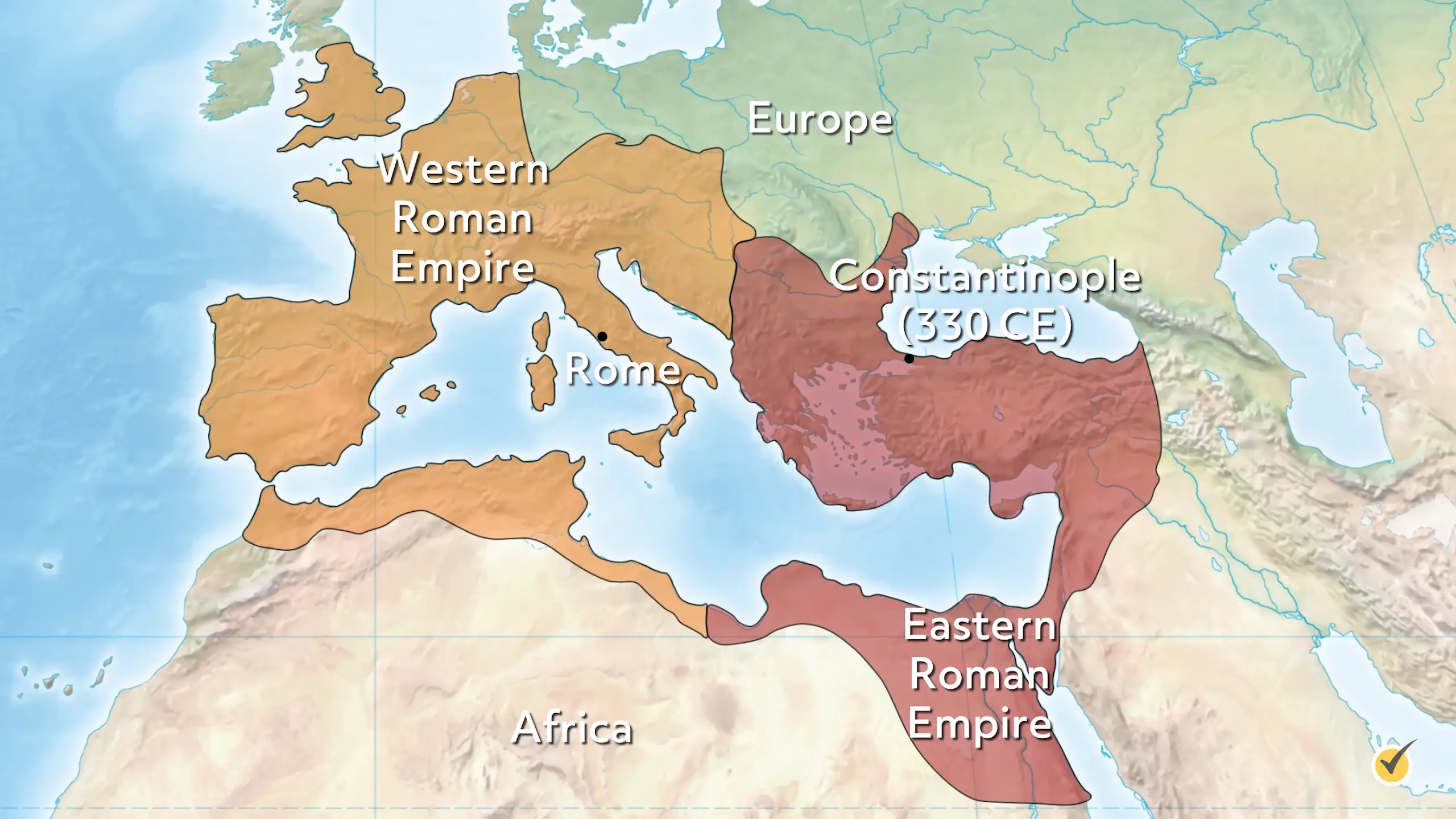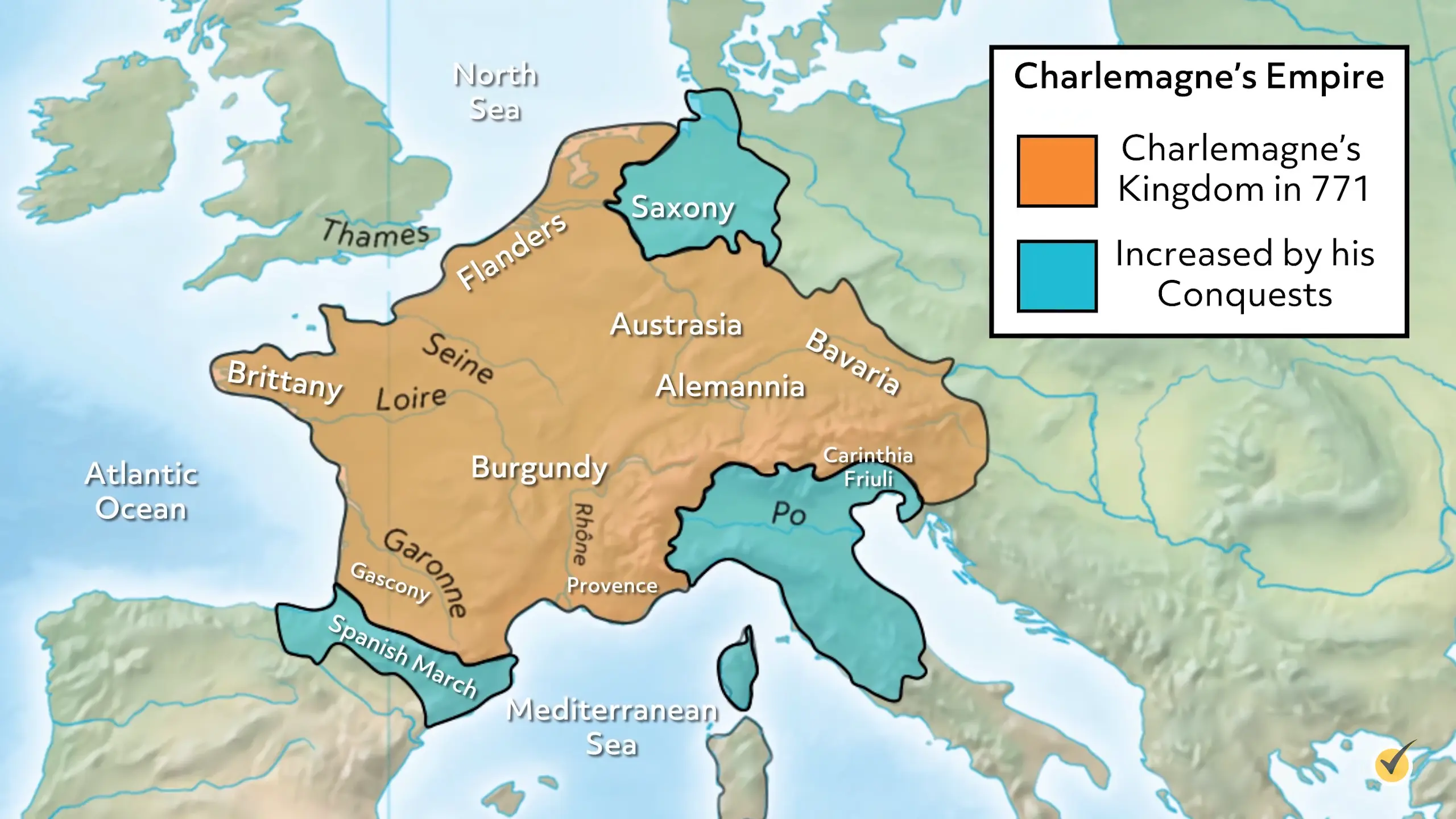
Feudalism in Western Europe was a politico-economic system that created a social fabric with military obligations. It produced a set of manners and norms—chivalry—and spawned an elegant form of literature that helped Europeans capture and develop pride in their histories.
But for the mass of the populace it was quite oppressive, and by the end of the medieval period it had run its course.
Let’s take a closer look.
Origins of Feudalism
The Fall of Rome and the Rise of Germanic Kingdoms
Before roughly 400 AD, much of Western Europe was under the dominion of the Roman Empire. At this point, the empire had already been divided into western and eastern parts by Diocletian, whose reign ended in 305.
But by the early 5th century, that division was becoming permanent—the eastern part prospered and eventually took the mantle of Roman authority, whereas the western part declined under repeated invasions from foreign tribes and officially ended in 476. These tribes, under the collective designation “Germanic,” though they didn’t necessarily originate in what is now Germany, had their own local laws under their own rulers that didn’t answer to a centralized authority in Rome.

Charlemagne and the Frankish Model of Feudalism
To maintain power and forestall any attempt to usurp his authority, a Germanic king would grant lands to his nobles in return for their pledging military support when the king summoned it. By the latter part of the 8th century, the most successful practitioner of this system was a Frankish ruler named Charlemagne, who built an empire that covered a significant, though truncated, portion of the former Western Roman Empire.

Through a concerted, highly-detailed legal system and a centralized spy service, Charlemagne verified that nobles throughout the empire were obeying his authority. In return for these nobles lending him the support of their soldierly retainers–known as knights–the Frankish ruler allowed the nobles to own allotments of land within the empire. This Frankish version of feudalism was the blueprint for the version that steadily took hold throughout much of Western Europe.
The Structure of Feudalism
At its core, the system was not only a hierarchy of relationships that included military obligations, but also an economic system based solidly on agriculture. The king offered protection and, to the nobles, sections of land known as manors or fiefs. Because of its agricultural base, feudalism in Western Europe took hold most widely in areas that were then primarily rural – including Germany, England, and the northern part of France.
Feudal Hierarchy
The glue that held feudalism together was the oath of fealty, or loyalty – in essence, a promise of faithful service to one’s higher-up in the feudal hierarchy. Fealty was itself impressed upon the participants with the help of religion. It was arranged through a formal ceremony called homage, reminding a man that divine retribution would come his way if he broke the oath.
The King: Ruler by Divine Right
The authority of the king under feudalism, meanwhile, was validated by “divine right,” which alleged that God had granted kings the discretion to control and dispose of their lands as they saw fit. Because a king’s legitimacy depended on the rest of the kingdom believing he genuinely had this right and wasn’t just saying so, many monarchs throughout the medieval period actively sought and received official sanction for divine right from the papacy in Rome. The Catholic pope was seen and utilized as a conduit for granting the divine right of kings. Charlemagne made use of this institution when in December of 800 he was crowned emperor by Pope Leo III.
Nobles: Lords and Vassals
Moving down the feudal hierarchy, the next tier consisted of the nobles. As recipients of lands from a king, which they either owned or leased, nobles were known as vassals, and of course their lords were their kings. As part of their oath of loyalty to the king, the vassal nobles had the specific obligation to render military protection through provision of armies, which included heavily armed cavalry soldiers who were their vassals, otherwise known as knights. The nobles, in turn, were regarded as lords by the knights they ruled within their fiefdoms. Often a noble would be required to provide a stipulated number of knights to the monarchy, proportioned to the size of that noble’s fief.
Nobles had a high level of autonomy in their territories, since they and not the king were often the highest-ranking individuals on location. These nobles utilized their rights to create codes of law, collect taxes, and circulate their own currencies. They served as mediators, or judges, in hearing and deciding on disputes in all of these areas and in approving marriages of subjects – though in the more important criminal and civil cases, the king reserved the sole right to judge. Intriguingly, another class of individuals which had rights equal to those of the nobles under feudalism was the clergy of the Roman Catholic Church. They, too, received fiefs from monarchs, based themselves in elegant houses, gained revenue from the lands, were required to furnish fighting men for the king’s defense, and sat as judges in legal cases in their jurisdictions. As the Middle Ages went on, the ranks of the nobility and royalty right below the king overlapped with the clergy: there were prince-bishops who wielded enormous power.
Knights
Below the nobles, as I mentioned, were the knights. They didn’t universally own land – usually the knights who owned land were those in particularly large fiefdoms too large even for a noble to govern. Knights who were granted fiefs of their own had often shown their mettle in some way, for instance by fighting bravely in battle. They had to collect taxes, fight on behalf of their lords, and provide soldiers from their lands (if they owned them) when ordered. In cooperation with the nobles, the knights were also required to pay for their own equipment for battle and to pay for the conscription of any additional soldiers demanded.
Whether fighting directly for their lords or in combination with their lords for the king, knights had a mandatory period of military service of 40 days, which in certain circumstances could be increased to 90 days. Throughout the rest of the Middle Ages, there was real social mobility available to the knights-in-training – from the age of 7 known as pages and from the age of 14 as squires – who could eventually become knights and gain patronage and wealth from their lords. The code of conduct regulating praiseworthy knightly behavior, known as chivalry, was flowering. Knights used it to develop and promote the identity and ideals of their class through mock military encounters called tournaments. With monetary winnings from these tournaments, knights could augment their revenues and then buy lands or increase the size of lands already held, paving a way into the nobility.
Economic Foundations
Peasants and Serfs
The revenues levied by lords and knights came from the lowest part of the feudal hierarchy: the peasants. Much of the peasantry consisted of serfs, agricultural laborers banned from leaving the land of their lord without their lord’s permission. Those peasants who weren’t serfs and therefore had a measure of freedom could be and were often conscripted as infantry soldiers to join the cavalry detachments of nobles and knights.
The economic existence of peasants consisted mainly of grueling farm work in the fields, where they were required to grow crops and herd livestock to provide the food of the realm. In return for being allowed to keep a portion of their produce and reside on the land they farmed, they paid their lord a tax—sometimes in cash or as various menial duties, but often in the form of the rest of their produce. This tax, in whatever form it was paid, was known as a rent, and from this period of history came that term and the term “landlord,” designating the feudal lord who received the rent. From the feudal era in Europe we also get the terms “tenancy” and “tenants,” which were other words for fief and the peasants working the land of a fief.
The Decline of Feudalism
By the early 14th century, feudalism had become the norm in Germany, France, England, and much of Spain. That situation changed radically with the arrival of the bubonic plague, or Black Death. In the period from 1347 to 1351, up to half of the population of Europe was wiped out, decimating the ranks of lords and peasants alike. As a result, peasant tenants were working larger tracts of land, which had seen their laboring populations severely reduced.
The lords, in turn, found that their demand for labor was increased, but with the labor pool reduced in size, they had to entice peasants more to work for them—and they did this by bringing in a wage system and a cash-rent system that phased out the previous tenancy arrangements. With wages came financial independence, and with financial independence came the real possibility of moving from an agricultural fief into a town or city to become a skilled craftsperson. It was at this point that feudalism began rapidly receding in Western Europe – and society was gaining a new fluidity as the early capitalist structures of the Renaissance began to take form.
Review
Okay, let’s review before we go. The system of feudalism began to flourish in the late 8th century, with Charlemagne being the most prominent early practitioner of the system. The social hierarchy included monarchs, nobles, knights, and peasants and serfs. Each of these levels of hierarchy depended on each other, and once the Bubonic Plague wiped out a significant portion of the population, the system could not properly sustain itself anymore, and eventually dissolved.
Thanks for watching, and happy studying!
- “Feudalism.” n.d. Feudalism: Rights and Responsibilities
- “Knights.” 2019. Feudalism: Rights and Responsibilities
- “Nobles.” 2019. Feudalism: Rights and Responsibilities
- “Feudalism.” n.d. Catholic Answers
- “Feudalism.” Wikipedia
- Newman, Simon. 2012. “Feudalism in the Middle Ages.” The Finer Times
- Laurits, John. 2018. “A History of Landlords: Rent & the Feudal Origins of a Non-Working Class.”
- “Infantry in the Middle Ages.” Wikipedia
- K. Kris Hirst. 2005. “Feudalism – a Political System of Medieval Europe and Elsewhere.” ThoughtCo
- “Black Death | Causes, Facts, and Consequences.” n.d. Encyclopedia Britannica

